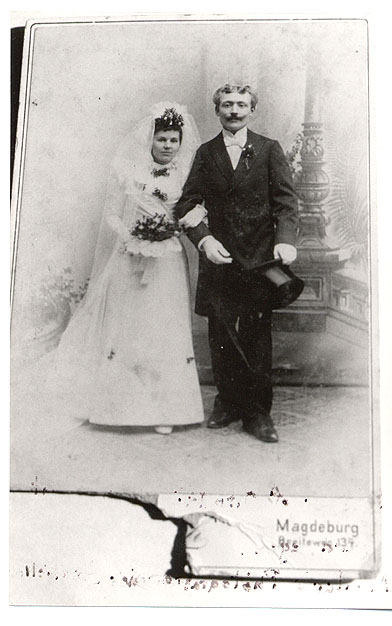Sign up for the Family Tree Newsletter Plus, you’ll receive our 10 Essential Genealogy Research Forms PDF as a special thank you!
Get Your Free Genealogy Forms
"*" indicates required fields
“Was a formal wedding unusual for the 19th century?” Cora McDonnell asks about this wedding photograph of her grandfather’s brother and his wife. In this case, the story surrounding the photograph is as fascinating as the image itself.
Cora’s grandfather, Otto Frederick Richter, born March 16, 1864, immigrated in 1882 from a small village in what is now Germany. He traveled through New York City, eventually landing in Memphis, Tenn. According to the family he left home to avoid military service, making the journey alone. Otto’s one brother and two sisters remained behind. He continued to communicate with his family and in turn, they sent him letters and photographs. At some point after Otto’s death in 1908, the letters were discarded because no one could read them, but his children kept the photographs. In Cora McDonnell’s collection is this wedding portrait as well as pictures of Otto’s sisters and his mother.
Unfortunately, without the letters, some of the images lack identification. For instance, Cora knows how the individuals are related to her, but has been unsuccessful in finding their names or in dating the images. Some of the pictures list Magedeburg or Gardelegen as the photographer’s location. In the image submitted for identification, the name of the studio is broken off.
Nineteenth century weddings could be very elaborate, but it usually depended on the financial circumstances of the couple. Wedding attire was expensive and some women chose to decorate one of their best dresses with a veil and flowers rather than purchase a new dress that would be worn only once. This couple chose to wear formal outfits for the occasion of their marriage.
The groom wore a long mourning coat with solid dark trousers with a top hat, as well as a white shirt, tie and gloves. A small corsage of flowers is in his lapel. This attire may have been dark blue or maroon, since solid black was usually reserved for mourning.
The bride’s dress dates the picture to circa 1890. She is wearing a full veil that descends to the floor and is gathered into a puff at the front of her hair with a small group of blossoms. Additional flowers pinned to various places on her dress including the skirt add detail. This followed the fashion set by royal wedding dresses of the period. Other dating clues are the tight sleeves with puffed shoulder seams and the style of her veil. Her skirt does not touch the ground and is short enough to show her shoes. The bodice treatment is very interesting. It appears that fabric is draped across the front while the cloth near the neck appears different. It is possible that she either converted an existing dress or meant to remove the neckline piece to change it into an evening dress for later use.
This wedding portrait illustrates just one of the many wedding customs that existed in the late 19th century. It is unfortunate that the names of the individuals in the picture are unknown.
Find out how to submit your own picture for possible analysis by Maureen Taylor. E-mail her at mtaylor@taylorandstrong.com.
ADVERTISEMENT


